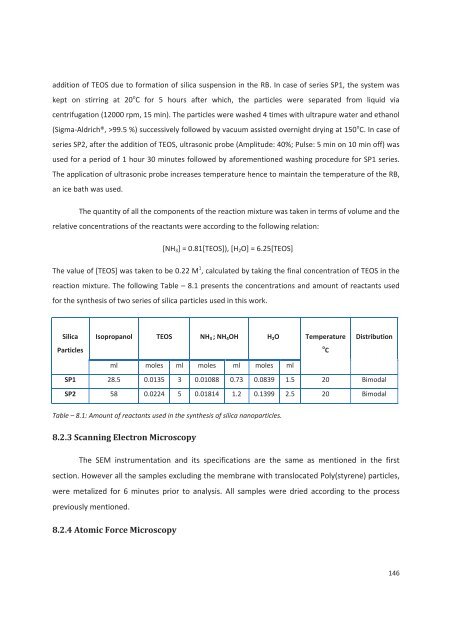4(%3)3 - Ecole nationale supérieure de chimie de Montpellier
4(%3)3 - Ecole nationale supérieure de chimie de Montpellier
4(%3)3 - Ecole nationale supérieure de chimie de Montpellier
You also want an ePaper? Increase the reach of your titles
YUMPU automatically turns print PDFs into web optimized ePapers that Google loves.
addition of TEOS due to formation of silica suspension in the RB. In case of series SP1, the system waskept on stirring at 20 o C for 5 hours after which, the particles were separated from liquid viacentrifugation (12000 rpm, 15 min). The particles were washed 4 times with ultrapure water and ethanol(Sigma-Aldrich®, >99.5 %) successively followed by vacuum assisted overnight drying at 150 o C. In case ofseries SP2, after the addition of TEOS, ultrasonic probe (Amplitu<strong>de</strong>: 40%; Pulse: 5 min on 10 min off) wasused for a period of 1 hour 30 minutes followed by aforementioned washing procedure for SP1 series.The application of ultrasonic probe increases temperature hence to maintain the temperature of the RB,an ice bath was used.The quantity of all the components of the reaction mixture was taken in terms of volume and therelative concentrations of the reactants were according to the following relation:[NH 3 ] = 0.81[TEOS]), [H 2 O] = 6.25[TEOS]The value of [TEOS] was taken to be 0.22 M 1 , calculated by taking the final concentration of TEOS in thereaction mixture. The following Table – 8.1 presents the concentrations and amount of reactants usedfor the synthesis of two series of silica particles used in this work.SilicaParticlesIsopropanol TEOS NH 3 ; NH 4 OH H 2 O Temperatureml moles ml moles ml moles mlo CDistributionSP1 28.5 0.0135 3 0.01088 0.73 0.0839 1.5 20 BimodalSP2 58 0.0224 5 0.01814 1.2 0.1399 2.5 20 BimodalTable – 8.1: Amount of reactants used in the synthesis of silica nanoparticles.8.2.3 Scanning Electron MicroscopyThe SEM instrumentation and its specifications are the same as mentioned in the firstsection. However all the samples excluding the membrane with translocated Poly(styrene) particles,were metalized for 6 minutes prior to analysis. All samples were dried according to the processpreviously mentioned.8.2.4 Atomic Force Microscopy146











